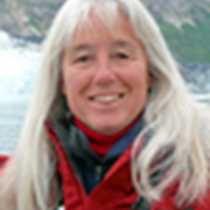Tracy Arm Fjord & Williams Cove
Early this morning the National Geographic Sea Bird entered Tracy Arm, a twisted, narrow, deep fjord restricted by high, precipitous rock walls. Sculpted by glaciers, this wilderness has some of the most impressive scenery in all of Southeast Alaska. In the brilliant sunshine, we passed myriad waterfalls and then slowed as we approached the end of the fjord where we encountered icebergs that had calved from the tidewater glaciers that tumble into the sea from the Coast Mountains to the east. Mother and kid mountain goats were seen at the tide line and we watched in amazement as they deftly climbed up the steep slope in no time at all – with the kid in the lead!
We passed Marguerite Island and continued to South Sawyer Glacier. Harbor seals, many with pups at their side, were resting on the icebergs in front of the glacier. Some popped up in the water near the ship, turning curious faces with big brown eyes toward us. If the tidewater glaciers continue to recede as rapidly as they have recently, the seals will no longer have the iceberg habitat that is so important to them, as the ice provides birthing platforms and protection from predators. Arctic terns, however, benefit from the melting glacier, which provides nesting habitat on the bare rock and gravel that it leaves behind.
Groups of guests boarded the Zodiacs for a seal’s-eye-view of the icebergs and glacier. There was quite a bit of activity, with small bits of ice falling from the face of the glacier, punctuated by occasional larger calvings. The suitable descriptive term for the sight and sound of a calving tidewater glacier is “white thunder.” All of our senses were stimulated by our surroundings, even touch and taste as some of us felt, held, and sampled 200-year-old pieces of ice.
With everyone back on board, the N.G. Sea Bird turned and retraced its wake back down the waterway. It was warm on the decks and the scenery was magnificent. We visited a beautiful waterfall called “Hole-in-the-Wall,” so named because of a pothole in the face of the rock formed and deepened by water-tumbled stones. Captain Coughlin nosed the bow of the ship underneath the waterfall, showering anyone within its reach.
In the afternoon we anchored in Williams Cove where we had the opportunity to walk in the forest or kayak in the bay. It was a nice introduction to the ecology of the Tongass National Forest - the nation’s largest, at almost 17 million acres.
Light lingers late in these near-solstice days, giving us time to check for wildlife before turning in for the night. We culminated this superb day with a sighting of a humpback whale - spouting, surfacing and diving with a show of its black and white flukes as it disappeared below the surface.




